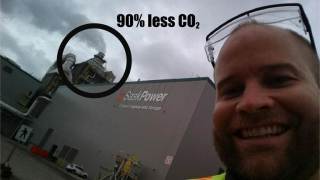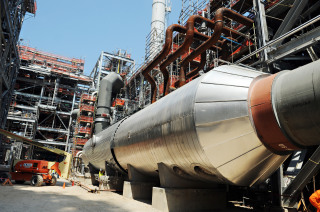
Joint letter – ICC reform and expansion risks diverting ETS Revenues from real climate action
In light of the European Commission’s ongoing considerations to amend the ETS State Aid Guidelines, revising the rules for Indirec...
News

Publish date: October 2, 2014
News
SASKATCHEWAN, Canada – Canada has switched on the world’s first commercial-scale CO2 capture and storage (CCS) coal burning plant, which will allow it to burn fossil fuels without nudging the world closer to climate catastrophe, Bellona Europa, which was present for the occasion, said Thursday.
The project – a €1 billion, 110 MW retrofit of SaskPower’s Boundary Dam coal-fired power plant in Saskatchewan, Canada – will capture some 90 percent of climate changing carbon emissions before they go up the chimney.
State-owned SaskPower said Boundary Dam unit will trap around 1 million tons per year of the greenhouse gas CO2, or the equivalent of taking 250,000 cars off the road, in one of the more fossil fuel-dependent regions of Canada.
The captured CO2 will be then be injected into nearby oilfields to enhance oil recovery, turning waste into a money-spinner.
SaskPower cut the ribbon to the unit on Thursday. Among the guests invited to the ceremony was Bellona Europa Director Jonas Helseth. Bellona has been working with CCS as a potent climate solution for more than two decades.
“This is an extremely important event for those few of us who are still trying to communicate the need for CCS in Europe, because what has been accomplished here it makes it impossible for opponents to say CCS is to difficult to accomplish, or that the technology is not ready to deliver,” said Helseth, adding that the success of the project “comes at a time when we need to reinvigorate CCS momentum in Europe.”

Not the first CCS attempt, but the largest
Boundary Dam is far from the first plant to attempt capturing emissions.
By turning its coal into combustible gas, Mississippi Power’s Kemper plant should be operational next year, capturing 3.5 million tons of CO2 per year, or 65 percent of the plant’s annual emissions. Texas is laying out similar plans.
A dozen other projects are underway around the world, and more than 20 in development. But the Canadian plant is the first large-scale project to flip the big “on” switch.
Helseth noted that Canada and CCS seem to be odd bedfellows.
“Canada is often seen by activists the home of the world’s climate deniers, and now they are the first country in the world to deliver on the technology that can deal with the constantly increasing used of coal,” he said.
Unfortunately, Boundary Dam and similar projects don’t provide an easy template for the rest of the world to follow, so it represents something of an isolated success story. This is mainly due to navigating the craggy economics of CCS, which offer very narrow options for selling off the carbon to pay for the new tech.
Fending off emissions ‘essential’
Finding a way to clean up coal-fired power plants is, nevertheless, critical to the world’s ability to fend off the most horrific effects of climate change.
Helseth said that anyone who’s read the most recent IEA coal report and understands the magnitude of climate change also has to realize that without CCS technology in place on a vast scale, other arrows in the quiver against climate change are blunted.
“What we see here in Saskatchewan is that CCS can be done in a relatively short time and for acceptable costs compared to doing nothing,” he said.
Scientists from the United Nations Intergovernmental Panel on Climate Change agree, and said earlier this year in their Fifth Assessment report that without broad deployment of CCS technology most of the world’s fossil fuel will have to stay in the ground to avoid dangerous climate change.
Maria van der Hoeven, the International Energy Agency’s executive director, called the Boundary Dam launch a “momentous point” in the development of CCS technology, saying it is “essential” if the world is to cope with the effects of burning fossil fuels.
The developing world, especially China, India and Southeast Asia, still relies on coal to fire its exploding economic growth. For his part, Prakash Javadekar, India’s environment minister told the New York Times in late September that his country’s economic development outranks rising greenhouse gases, and that coal will pave the road to its prosperous future.
“What cuts?” Javadekar told the Times. “That’s for more developed countries. The moral principle of historic responsibility cannot be washed away.”

For its part, China burns as much coal as the rest of the world combined. Despite plans to rely less on coal in response to domestic pollution protests, China’s economy is predictied to remain coal-based for decades.
The United States and Germany still turn to coal to provide one third of their electricity, and emissions in both countries continue to rise. Big US coal companies have yet to embrace CCS technology as they set their sights on new power plant emission rules set to be issued by the Environmental Protection Agency.
The difficult path to CCS
The road to Boundary Dam has not passed without its share of potholes: like most power production projects that try to combine power production and CCS, it has been plauged by delays, cost overruns and criticism for accepting government subsidies.
Many CCS projects have simply sunk, and even Norway’s prized Mongstad project was dropped in 2013 – to withering national criticism from Bellona President Frederic Hauge – and was reinstated in the Norwegian state budget for 2014.
On resurrecting Norway’s role in CCS development, Minister of Petroleum and Energy Tord Lien said in May that, “We need to increase knowledge and reduce the costs to bring this technology to the market and make it attractive.”
“Norway and other countries need to continue to actively pursue technology and competence development, and develop projects for CO2 sequestration,” he said.
Cushioning CCS sticker shock
Still, the CCS unit at Boundary Dam cost €1 billion in total, or €8.7 million, for each of its 110 MWs of installed power capacity, Foreign Policy reported.
SaskPower said its overruns weren’t associated with CCS technology as much as other retrofitting issues as the 50-year-old coal plant, according to the Guardian newspaper The company has said it can bag its next CCS project for 25 percent cheaper.
And even though it’s good news that Mississippi Power’s Kemper plant will throttle up next year, even that date represents a delay brought on by a more than doubling of its initial costs to €4.4 billion as of today.

Overall, the cost factors means that coal plants fitted with CCS- technology could end up costing energy consumers 80 percent more than power produced by the old carbon spewing variety, various calculations have shown.
How to work the economics of CCS
Recouping these costs on a global level is therefore a central issue in creating more Boundary Dams. The two main approaches are levying heavy taxes on carbon emissions, or selling off the CO2 to improve the recovery of other fossil fuels. Neither choice is ideal.
The European Union has a long established carbon price of about €5.50 a ton. As of October 2013, China has initiated a so-called Carbon Pricing Survey in order to make its seven pilot programs viable ahead of a 2016 cap-and-trade program. Its suggested price for a ton of CO2 is €4.00, with rises envisioned in the future.
Yet, straight carbon taxes that are often tabled in the US – and shot down nearly as quickly – still are too low to make CCS the most obvious weapon for combating climate change.
SaskPower’s plan to sell of its carbon for use in liquefied form for enhanced oil recovery seems the most realistic for the moment.
But whether you’re able to make a buck selling the carbon depends on where you are on the map. Mississippi and Texas are all for squeezing the lemons of their oil wells, and even the Middle East is hoping to boost oil recovery by getting into the carbon game, Foreign Policy said. But countries that come up empty handed in oil production, like India and most Southeast Asian countries, don’t stand to make much on that option.
So, in many ways, CCS is still between a rock and a hard place, as the IEA spelled out in its CCS 2014 report, despite the leap forward Boundary Dam has given the technology.
Just pumping CO2 into massive underground formations is a hard economic sell, but at least offers priceless peace of mind that it’s not in the atmosphere.
Using it to juice more oil out of old ketchup bottle wells surely gets CO2 out of the atmosphere and boosts budget reports for oil companies and CCS tech alike. But it also threatens to knee cap the whole effort by providing yet more fossil fuels that are just getting burned in different kinds of emissions that cannot be sucked out of the air once they come out the tailpipe.
In the end, though, as Helseth said, the cost arguments make no sense.
“It’s not about cost – it’s about financing,” he said. “If you set up the financing correctly with the right incentives, the financing of CCS works. If you further compare investing in CCS to just burning coal without it, the cost to global society in the future will be much, much higher than investing in CCS today.”
So far, though, Helseth said the right incentives have not been used. Standard complaints that the technology isn’t ready, such as those forwarded by Norway when it binned its Mongstad project, are now mute in the face of Boundary Dam’s success.
“If you put the right incentives in place, as we see here in Canada, you can deliver on CCS quickly, which totally voids the argument that the technology is not ready.”

In light of the European Commission’s ongoing considerations to amend the ETS State Aid Guidelines, revising the rules for Indirec...

Today, the European Commission published a series of Carbon Border Adjustment Mechanism(CBAM)-related documents including two legislative proposals a...

Today, the European Commission published its European Grids Package, presented as an upgrade of the EU’s energy infrastructure to lower bills and boo...

The European Commission is set to publish the the Grids Package on December 10th, the different legislative proposals and secondary legislations rela...

Today, the European Commission adopted a new Union list of energy Projects of Common Interest (PCIs) and Projects of Mutual Interest (PMIs), granting...
Get our latest news